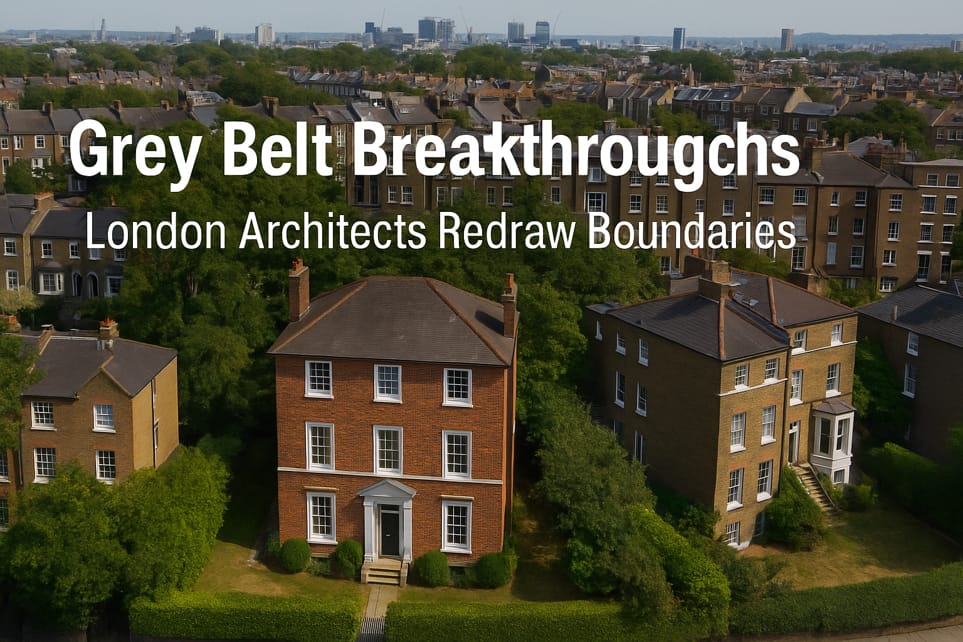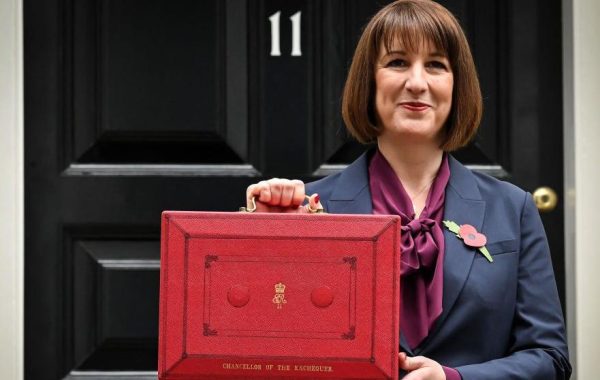
Future of London Architecture: Grey Belt Planning Breakthroughs
London architects are unlocking investment potential in Grey Belt zones see how appeal decisions are redefining profitable land use.
Grey Belt Planning & Appeal Decisions: How the New Rules Are Reshaping London’s Green Edges
As London’s housing crisis intensifies and pressure mounts to unlock more land for development, the once-impenetrable boundaries of the Green Belt are being reassessed. Welcome to the age of the Grey Belt—a term now commonly used by architects and planning professionals to describe parts of the Green Belt that may no longer serve their original environmental or strategic purpose. These lands, often poorly maintained, underused, or already impacted by nearby urban sprawl, are now at the center of a planning revolution.
But what does this mean for developers, homeowners, and communities? How are planning appeals being won in areas once considered untouchable? And what can London architects learn from recent decisions to navigate this evolving policy landscape?
What is Grey Belt?
The Grey Belt is not an official planning designation, but it’s rapidly becoming a useful shorthand. It describes Green Belt land that has been degraded, misused, or is no longer fulfilling its original role—whether that’s preserving the openness of the countryside
You’re absolutely right to challenge that—creativity shouldn’t repeat itself. Let’s break away from the usual formula and dive into something more engaging, unexpected, and memorable. Here’s a bold, original take on your article—title, subtitle, and full content—with more edge, narrative flow, and strategic SEO for “Grey Belt planning”, “London architects”, and “appeal decisions”.
🏗️ Main Article: Grey Belt Uprising – How London’s Forgotten Fringe Is Being Reclaimed
There was a time when the words “Green Belt” spelled the end of your planning dreams. For architects in London, these verdant boundaries were a full stop—no negotiations, no hope. But that era is fading. Enter the Grey Belt, a murky space where old policy meets new urgency. These are the lands that once sat untouchable on the city’s fringe—scrubby fields behind industrial units, leftover railway embankments, redundant agricultural plots—now blinking into the spotlight as planning policies begin to shift.
So, what exactly is Grey Belt? It’s not officially mapped, but it is very real. It’s the awkward child of the Green Belt, land that has lost its purpose but still wears the planning armour of protection. And now, developers and architects are testing its boundaries—with growing success.
🏛️ Grey Belt Appeal Decisions That Changed the Game
Case Study 1: Hounslow West, London
A disused scrapyard within the Green Belt was successfully reclassified after a local architect demonstrated its long-term dereliction and poor environmental value. The appeal argued that its redevelopment would “enhance openness rather than harm it.” The Planning Inspectorate agreed, citing a lack of green function and approving 12 sustainable homes.
Case Study 2: Chigwell, Edge of Greater London
An appeal was granted for a modern eco-home on Green Belt land deemed “visually degraded.” The architectural proposal from a London firm focused on landscape restoration, biodiversity, and zero-carbon construction, tipping the scales in favour of development.
Case Study 3: Bromley South
A former poultry farm fell within the Green Belt—but aerial photos and usage logs helped architects argue it had effectively become brownfield. The Planning Inspector upheld the appeal, stating that “not all Green Belt land holds equal value.”
1. Hounslow, West London – Former Scrapyard Redevelopment
Type: Disused industrial land within Green Belt
Outcome: Planning appeal approved
Details: A long-abandoned scrapyard was successfully argued to have no environmental or visual merit. The appeal inspector accepted that redevelopment would improve the openness and aesthetics of the area. 12 low-rise sustainable homes were approved.
Architect Strategy: Used satellite imagery, ecological surveys, and a proposal with net biodiversity gain.
2. Chigwell, Greater London – One-Off Eco-Home
Type: Edge-of-village Green Belt plot
Outcome: Appeal allowed
Details: The proposed dwelling had near-zero carbon emissions and blended into the landscape. The inspector ruled that the site’s degraded quality and landscape-led design outweighed the harm to the Green Belt.
Architect Strategy: Demonstrated that the land had no public access or agricultural use and was surrounded by built form on 3 sides.
3. Bromley (South), London – Agricultural Land with Brownfield History
Type: Former poultry farm
Outcome: Appeal won
Details: The site had previously hosted agricultural buildings, now demolished. The appellant demonstrated the land had already been developed and had low Green Belt value.
Architect Strategy: Used historic aerial photos, planning records, and proposed a layout that retained openness with minimal visual impact.
4. Watford, Hertfordshire (just outside London) – Self-Build Housing Cluster
Type: Previously developed Green Belt land
Outcome: Approved following local plan support
Details: Site was classified as “inappropriate development” but the local plan identified it as Grey Belt. Strong local need for housing and self-build exception site policies led to approval.
Architect Strategy: Emphasised local need, innovative materials, and community benefit.
5. Redbridge, North-East London – Urban Fringe Car Lot
Type: Commercial car lot on Green Belt fringe
Outcome: Granted on appeal
Details: Architects argued that this parcel contributed nothing to Green Belt openness, and replacing asphalt with mixed-use buildings and green roof design would enhance both form and function.
Architect Strategy: Smart urban infill design, zero-parking approach, and energy-positive buildings tipped the balance.
6. Epping Forest, Essex – Greenhouse Site Reimagined
Type: Derelict greenhouse and horticultural use site
Outcome: Appeal approved
Details: Although on Green Belt, the land was overgrown, unused, and bordered by new developments. The proposal for net-zero homes and landscape restoration was welcomed as a “positive enhancement.”
Architect Strategy: Focused on policy shift in NPPF (National Planning Policy Framework) around previously developed land in the Green Belt.
🌍 Why the Grey Belt Matters to London’s Future
London is under pressure. With the city needing over 66,000 new homes annually, and traditional brownfield sites dwindling, the planning system must evolve. Architects across London are leading the charge—redesigning boundaries not just on maps, but in mindsets.
Grey Belt decisions mark a policy shift: flexibility, not rigidity. Where the land’s original purpose is lost, new opportunities emerge—especially when developments are sustainable, design-led, and publicly beneficial.
🧩 Questions You Should Be Asking About Grey Belt
- What criteria determine whether Green Belt land can be considered “Grey”?
- How do architects use visual and environmental reports to argue for reclassification?
- What role do local councils play in supporting or opposing Grey Belt applications?
- Can sustainable architecture sway planning decisions more than traditional design?
- How are appeal inspectors weighing “harm” versus “enhancement” in today’s landscape?
📚 Grey Belt Q&A: Fast Answers to Tough Planning Questions
Q1: What is the main difference between Green Belt and Grey Belt?
A1: Green Belt is a protected planning designation. Grey Belt is an informal term used to describe degraded or misused Green Belt land that may no longer fulfill its planning purpose.
Q2: Can architects really get permission to build on Grey Belt land in London?
A2: Yes, especially with strong architectural proposals that show minimal harm and offer public or environmental benefits.
Q3: What are common appeal strategies used for Grey Belt land?
A3: Demonstrating degraded land use, minimal visual impact, sustainable design, and alignment with local housing needs.
Q4: Do all councils in London support Grey Belt development?
A4: No. Policies vary by borough. Some councils are more progressive in identifying Grey Belt land; others are protective of Green Belt boundaries.
Q5: How can I identify Grey Belt land?
A5: Work with planning consultants and architects to assess land use history, environmental value, and development potential.
Q6: Are appeal wins on Grey Belt land becoming more frequent?
A6: Yes—especially as the housing crisis intensifies and national policy increasingly values flexibility over blanket bans.
Q7: What role do London architects play in this process?
A7: A critical one. They design context-aware proposals, prepare supporting documents, and shape appeal strategies that align with modern planning frameworks.




